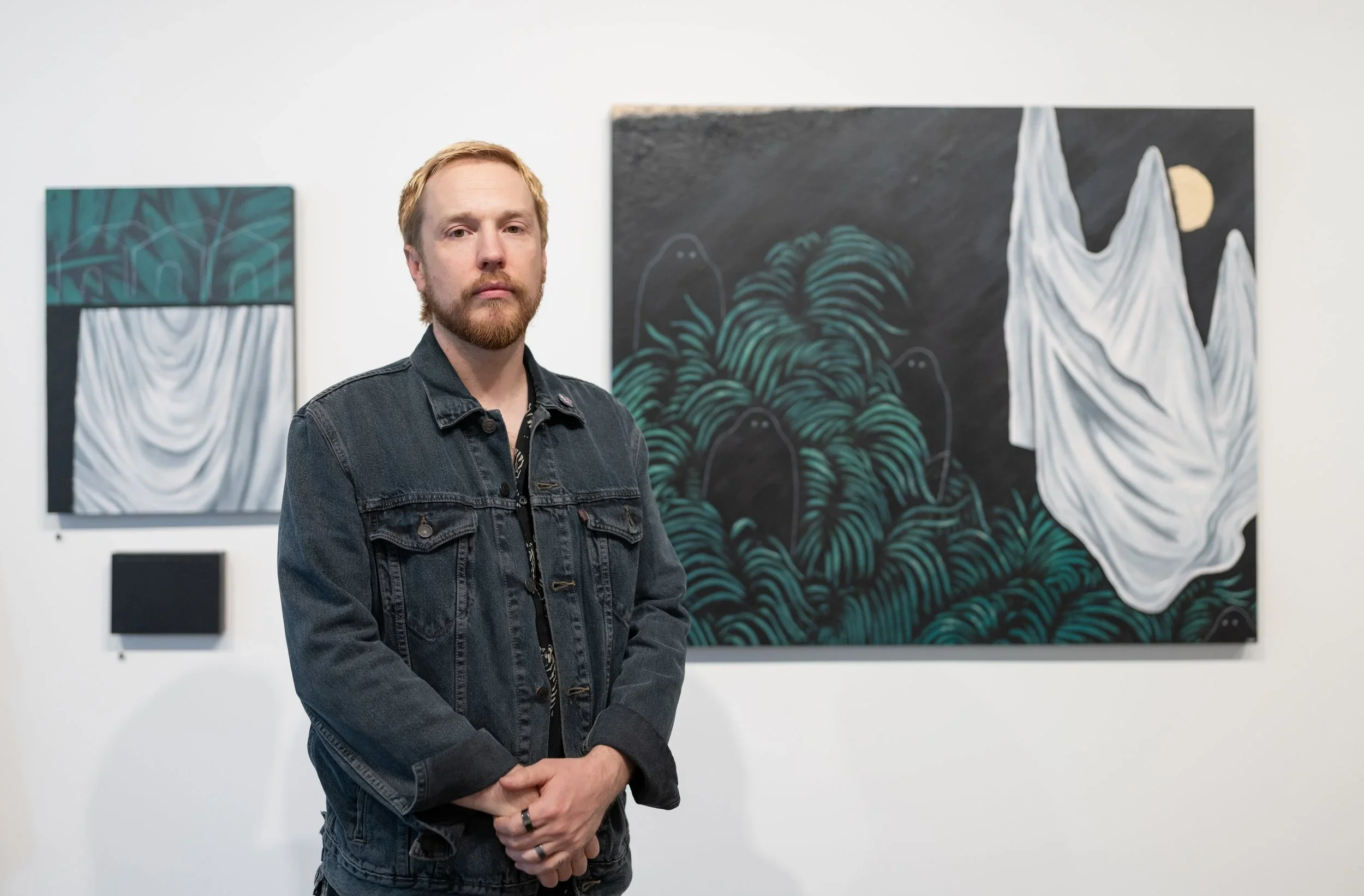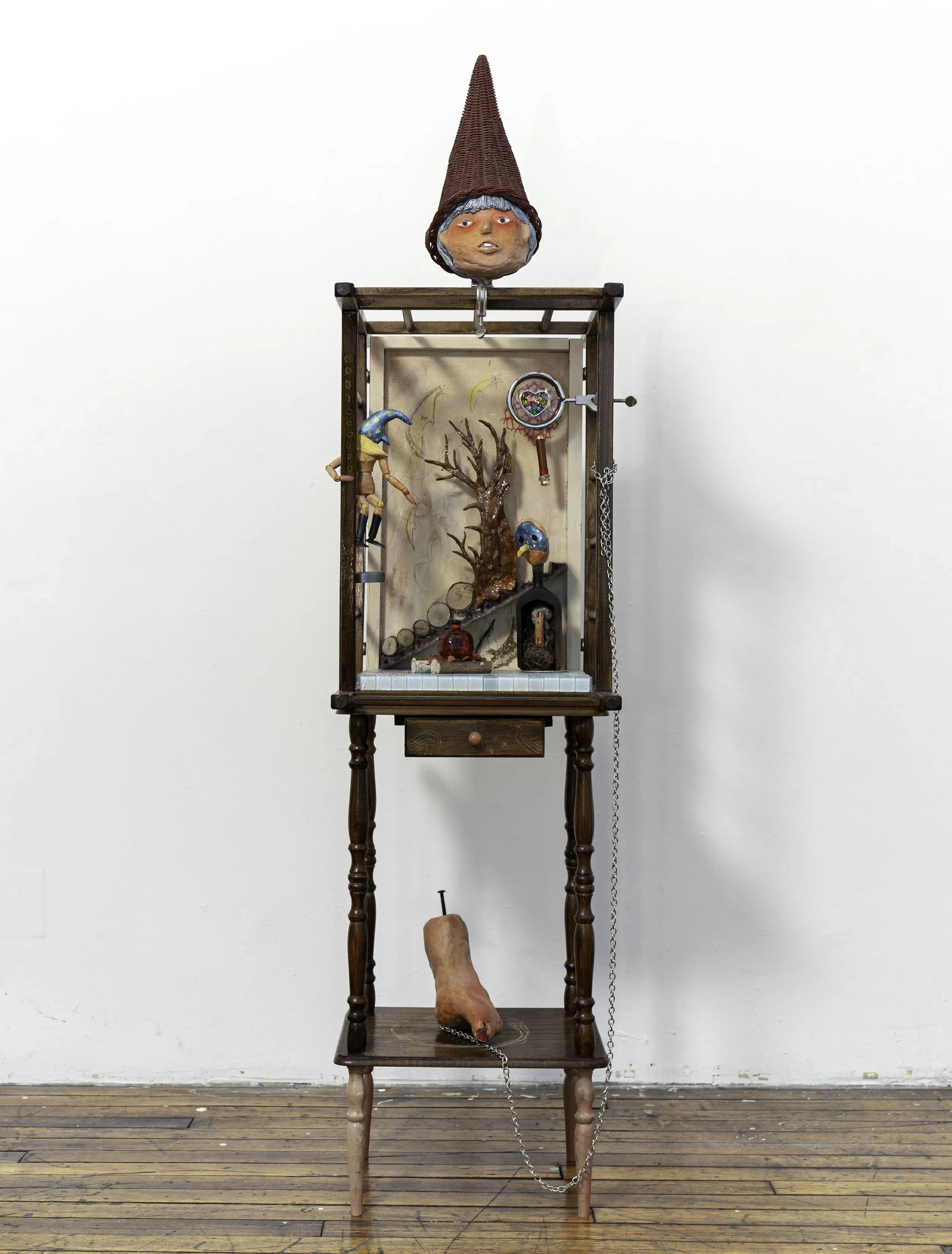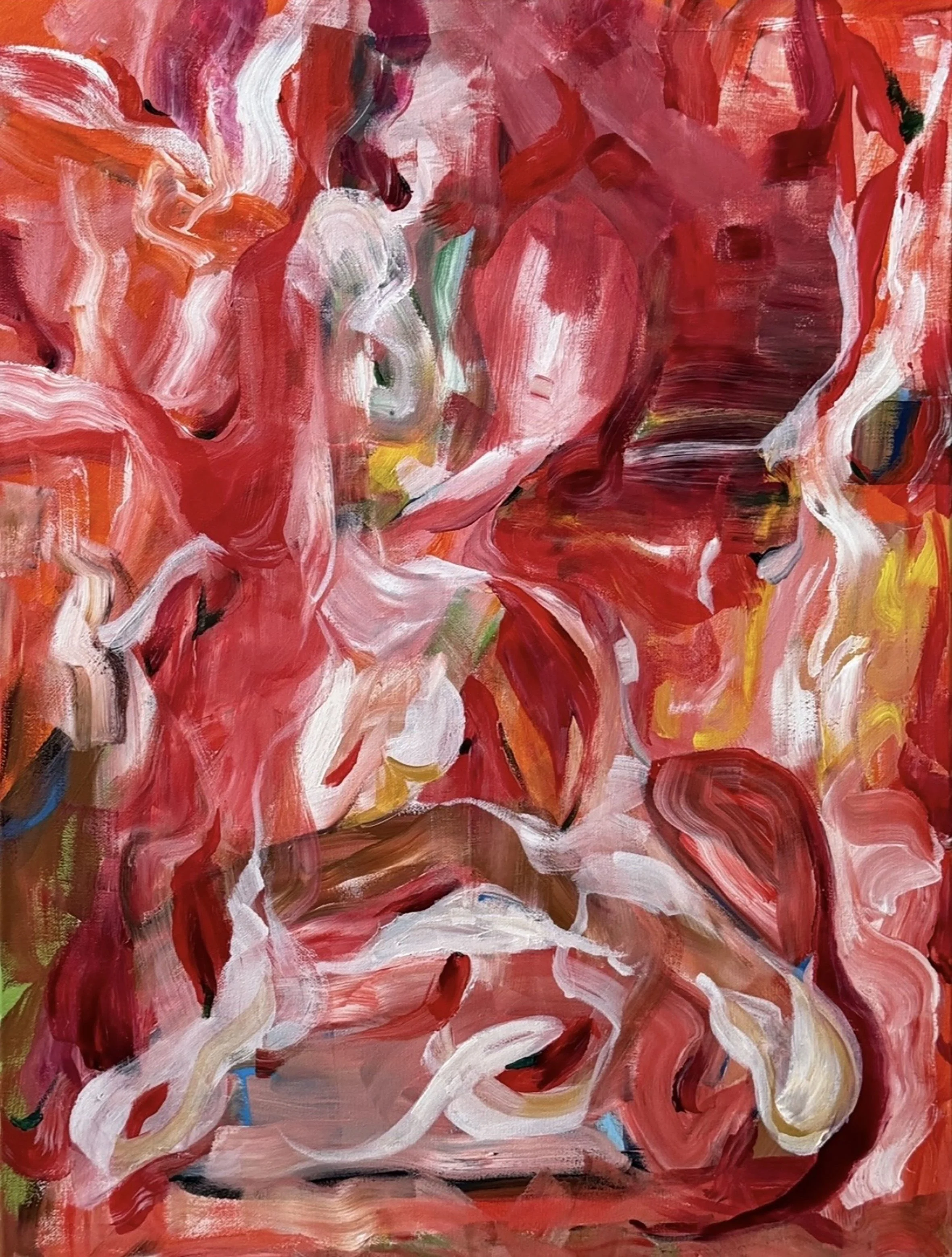10 Questions with Xiaohan Jiang
Al-Tiba9 Art Magazine ISSUE15 | Featured Artist
Jiang Xiaohan is a painter and poet from China, currently based in Chicago. She is expected to complete her Master's degree at the School of the Art Institute of Chicago in 2025.
Drawing inspiration from memories of the past and visions of imagination, Xiaohan paints the nostalgic bonds between her homeland's landscapes and nature; through her personal experiences, she explores the pursuit of faith and self-redemption against the backdrop of East Asian cultural and political contexts. In 2022, Xiaohan held a solo exhibition in Lebanon. Her works have been exhibited and collected across Asia, North America, and Europe. She has published a collection of poetry titled "Gifts: Selected Poems by Jiang Xiaohan 2004-2015".
Xiaohan Jiang - Portrait in her studio
ARTIST STATEMENT
“My paintings often have an embedded concern for social justice and human freedom. The rural memory from my hometown in north of China with my imagination are my most inspiring fountainhead. As one poem of mine says, "A sigh, a laugh, a moan/ inside, as if something just shattered/ dogs, cattle and sheep, moss and sickle are sunk in sleep." As soon as I stand in front of the canvas, I can see "the green roots" grow out of my palette; I can feel the little horse from my childhood flying under my brush. The poetry evoked the interweaving of text and imagery in my head, crystallizing thoughts into floating colors and amorphous shapes. Under both internal and social turmoil, biblical stories helped me achieve peace and serenity, guiding me toward reconciling my identity as an Asian woman within the framework of Western culture.
Through my art, I jettisoned realism and pragmatism and abandoned perspective and shading. I picked up symbolism and abstractionism, using birds and horses as metaphors. I construct captivating spiritual worlds utilizing bold lines, volumetric forms, and vibrant colors. My paintings transcend mere visual representations; they are an invitation to partake in a liberation dance and heed the call of the soul.”
— Xiaohan Jiang
The Great Light, oil on paper, 30x40 in, 2023 © Xiaohan Jiang
AL-TIBA9 ART MAGAZINE ORIGINAL ISSUE15
INTERVIEW
First of all, let's start from the basics. You are both a painter and a poet. What do these two mediums have in common? And how do you use each one in your creative practice?
For me, painting and poetry inherently share a similar narrative language. In my process, poetry acts as scaffolding, enabling me to construct a framework of words and images that encapsulate my thoughts and emotions. These are not just thoughts; they are deeply personal and often reflect the idyllic days of my childhood in northern China. Poetry is an intimate journey through emotions, like a rehearsal, setting the stage in my mind. When it comes to painting, the actual performance unfolds—where these emotions and narratives come to life on the canvas in vibrant colors and forms.
As you near completion of your master's degree at the School of the Art Institute of Chicago, how has your academic journey influenced your artistic perspective and the themes you explore in your paintings and poetry?
The journey through my master's at SAIC has been nothing short of transformative. Being immersed in an environment rich with diverse thoughts and talents has propelled my paintings and poetry to new heights. I've embraced the courage to tackle intricate subjects such as identity, displacement, and the personal-political nexus. Ultimately, the rigorous academic atmosphere and the program's interdisciplinary nature have inspired me to dissolve the boundaries between mediums. My paintings have become wordless poems, while my poetry paints with its verses.
Untitled Battle, oil on canvas, 48x36 in, 2023 © Xiaohan Jiang
In your artist statement, you mention the interweaving of text and imagery in your head, "crystallizing thoughts into floating colors and amorphous shapes." Could you elaborate on how poetry and literature inspire your visual art?
Indeed, the interplay between poetry and visual art is pivotal in my creative process. Literature is a wellspring of inspiration and the impetus that propels my visual narrative. Immersion in the works of poets like Rilke and Marina Tsvetaeva allows vivid imagery and vibrant landscapes to influence my thoughts subtly. Such literary works sow the seeds that eventually bloom into the dynamic imagery of my paintings.
In my work, a single line of poetry can inspire the entire mood of a painting. I might let an evocative phrase guide the color scheme or composition, allowing the poem's essence to permeate the artwork. It's not about replicating the textual imagery literally but rather capturing its spirit, translating the rhythm and tone into brushstrokes and hues.
The amorphous shapes and floating colors mentioned in my statement are the visual equivalents of the poetic devices I encounter in literature. Just as poetry uses metaphor and symbolism to transcend the literal, my art uses abstract forms and colors to transcend the conventional visual narrative. These elements of my paintings invite viewers to dive into an interpretive experience, much like engaging with a poem, where multiple meanings and emotions can be discovered within a single piece.
You have a distinctive style with bold lines, volumetric forms, and vibrant colors. Can you discuss your creative process and how these elements contribute to the atmosphere and message of your artworks?
My creative process is akin to orchestrating a symphony; each element, from the bold lines to the vibrant colors, plays a critical role in harmonizing the visual melody of the artwork. I begin with the lines, finding the boundaries, and defining the structure. These lines aren't just static borders but dynamic and aggressive, capturing movement and emotion. The volumetric forms give depth and weight to the composition I created. They're the crescendo in the piece. This is where the play of light and shadow comes into effect, creating a dance that can be both subtle and dramatic. The colors are the final flourish. I choose my palette intuitively, often guided by the emotions I experience at the time.
This Must Be the Place, oil on canvas, 18x18 in, 2023 © Xiaohan Jiang
The Judgement In Winter, oil on canvas, 40x30 in, 2022 © Xiaohan Jiang
Your paintings often reflect concerns for social justice and human freedom. How do you integrate these themes into your creative process and visual storytelling?
My creative process starts with deeply reflecting on current social events, personal narratives, and historical contexts. As I paint, my strokes are deliberate; they carry the weight of the stories I intend to tell. For example, "The Judgement in Winter" was inspired by the COVID-19 lockdown event in China in November 2022. I use the contrast of a black background with bright colors to discuss absolutes in justice and bright, unyielding colors to symbolize the vibrancy of the human spirit in the face of adversity. The canvas becomes a battleground, and pigments are my weapon. My goal is to make the viewer pause, engage, and feel—whether it's the discomfort of a social injustice being laid bare or the uplifting sense of potential and hope in the fight for freedom.
You also rely on symbols and abstractionism. How do birds and horses serve as metaphors in your work, and what do they represent to you?
In my work, birds and horses are laden with symbolic significance, representing the freedom and resilience of the spirit. Birds, with their ability to soar, symbolize liberation. They embody the aspiration to rise above constraints and barriers, mirroring my desires for justice and dignity. Horses, on the other hand, symbolize strength and endurance. They carry the weight of burdens yet move forward gracefully and determinedly. To me, horses represent the relentless pursuit of freedom and the power of resilience in adversity.
Nomad Trilogy, oil on paper, 60x48 in, 2023 © Xiaohan Jiang
Your works are highly influenced by your background and the environment in Northern China, where you grew up. Can you share how memories of your homeland affect your work? What elements are directly influenced by these memories? And how, on the contrary, do you tweak them to fit into your narrative?
I spent most of my childhood with my maternal grandparents in the countryside of northern China. When I was four years old, I began to write poems and record the nature I saw, such as snowflakes, rain, rivers, and trees. Perhaps because of the lack of parental companions during childhood, I dedicated my emotions to mountains, wheat fields, and birds. Whenever I saw the distant ridge connecting the soil to form a skyline, I could feel the convergence of my parents' love. I realized that the love that mother nature can offer is infinite. My blood connects to branches, soil, and seeds.
I infuse abstraction and transformation within this memory framework. In juxtaposition, I tweak these elements, bending them to fit my narrative—depicting the idyllic with strokes of chaos and blurring lines to convey the complexity of emotions. This approach allows me to bridge personal history with themes of growth, loss, and the perennial quest for belonging.
Another surprising element in your work is the biblical stories and their significant role in guiding you toward peace and serenity. How do these stories inform the spiritual worlds and symbolic elements present in your paintings?
Biblical narratives are woven into the fabric of my paintings, serving as both anchor and compass in my artistic journey. They are a source of spiritual insight, offering a reservoir of themes such as redemption, sacrifice, and resurrection, which resonate deeply with my experience. In my paintings, you'll find that these biblical motifs are not always overt but rather interlaced subtly within the layers of paint and texture. They often emerge as motifs or symbols—sometimes a solitary figure, a serene landscape, or a poignant gesture that alludes to a biblical parable or a moment of divine revelation. These elements imbue my art with a quiet yet potent sense of serenity and peace, reflecting the inner calm these ancient stories bring to my life. I use these references not as didactic tools but as poetic devices to probe the more profound questions of existence.
Who loves the sun, oil and oil sticks on canvas, 18x16 in, 2023 © Xiaohan Jiang
Heaven and Earth, oil on panel, 14x11 in, 2024 © Xiaohan Jiang
You are still very young; what do you wish to accomplish in the future? And how do you plan to reach these goals?
As a young artist just beginning my career, I hold two main ambitions: to engage in meaningful conversations with the global art community and to enhance the depth of my work's themes. I envision a future where my art and poetry are appreciated aesthetically and as mediums that transcend cultural barriers and prompt societal introspection. To realize these goals, I intend to immerse myself in art by participating in exhibitions, artist residencies, and collaborative projects at home and abroad. Continuing education remains a priority, whether through academic pursuits or mentorship under esteemed artists, because ongoing learning is essential for developing my artistic expression.
And lastly, where do you see yourself and your work five years from now?
Five years from now, I envision myself as an established figure in the art world. I anticipate the culmination of several impactful series reflecting my artistry's evolution and thematic explorations. I also hope to contribute to the education and mentorship of emerging artists. By integrating my journey into teaching, I aspire to foster the spirit of innovation and inquiry that has propelled my work.



























